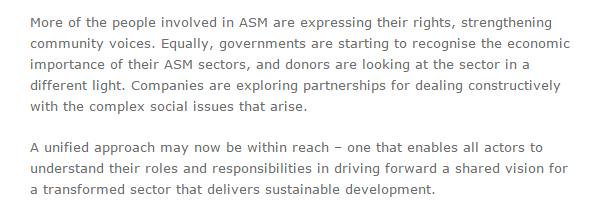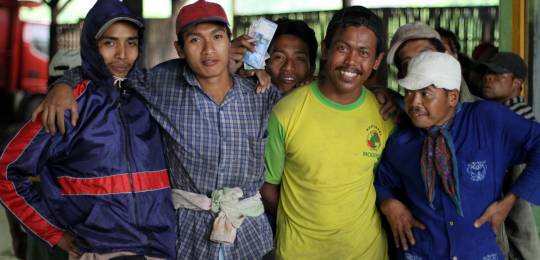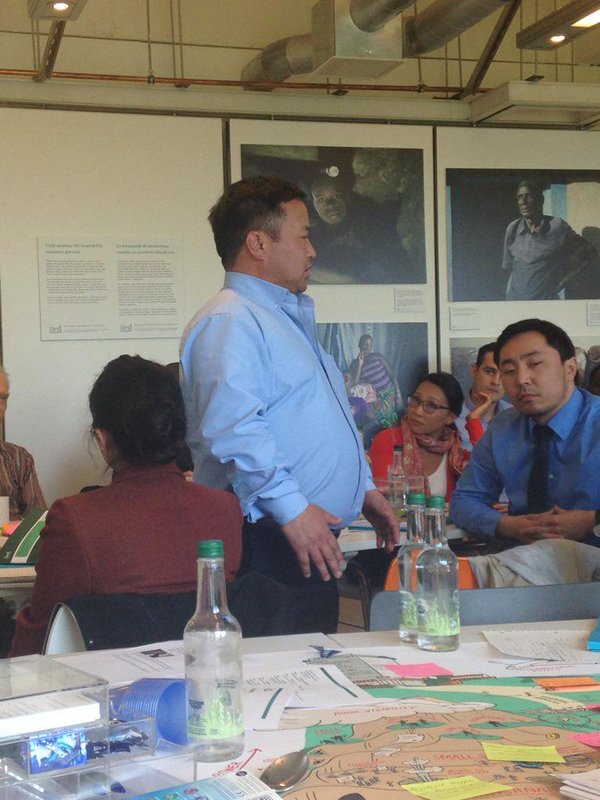Artisanal and small-scale mining visioning workshop
On 29 April, 2015, representatives from donors, industry, artisanal and small-scale mining, government and civil society gathered for the start of a two-day 'visioning workshop' to explore routes to a more inclusive and responsible gold mining sector. Follow the updates as it happened:
- Before the workshop, here's some background reading on how IIED is working to create a space for dialogue between different representatives of the mining sector
- BLOG: Not enough has been heard from local #mining voices in last 10 years, says @abbibuxton. This needs to change -> http://www.iied.org/listen-learn-lessons-small-scale-mining-sector …
 How can we ensure the #mining industry is inclusive of local voices? The solution is dialogue: http://www.iied.org/listen-learn-lessons-small-scale-mining-sector … pic.twitter.com/P7H37i7Of7
How can we ensure the #mining industry is inclusive of local voices? The solution is dialogue: http://www.iied.org/listen-learn-lessons-small-scale-mining-sector … pic.twitter.com/P7H37i7Of7 IIED's work towards inclusive & responsible #mining is collated here --> http://www.iied.org/towards-inclusive-responsible-mining … #ASM #MiningIndaba pic.twitter.com/spczwA8NUR
IIED's work towards inclusive & responsible #mining is collated here --> http://www.iied.org/towards-inclusive-responsible-mining … #ASM #MiningIndaba pic.twitter.com/spczwA8NUR Steve Bass' blog suggests dialogue could make a big difference in tackling problems/potentials faced by #ASM pic.twitter.com/zqNXhvLqtF
Steve Bass' blog suggests dialogue could make a big difference in tackling problems/potentials faced by #ASM pic.twitter.com/zqNXhvLqtF- ICYMI: Ahead of an IIED visioning workshop on artisanal & small-scale #mining, here's 5 essential #ASM resources --> http://www.iied.org/mine-information …
- ICYMI: Images from #Tanzania show diverse range of people that depend on #gold #mining - http://www.iied.org/gold-for-life pic.twitter.com/Q7N6a4lw44
- Day one:
- In London, IIED is today hosting a visioning workshop on artisanal & small-scale #mining #ASM @abbibuxton pic.twitter.com/OBtdrDfWKu
- The morning of the first day had seen stakeholders come together and agree that the long-term goal was to have ASM as a functional and sustainable business sector. The steps along the way, however, were still up for debate
- At the close of day one, stakeholders felt that a local-dialogue series on ASM must tackle the two elephants in the room: the issue of government capacity and injecting fresh thought and debate on how to formalise the sector, both of which hinged on market and rights-based approaches
- IIED's Sian Lewis shares some thoughts after day 1 of the #ASM visioning workshop --> http://www.iied.org/shared-long-term-vision-for-asm … #mining pic.twitter.com/V73pZbE9Aj
- Day two:
- #ASM #dialogue: How do we involve non-usual suspects in #artisanal #mining? We can't just preach to the choir! @IIED @abbibuxton
- It was agreed that any conversation on formalisation must begin with rights, and that a human rights approach was seen as important to help orient a more progressive vision for the future
- #ASM #dialogue: Formalisation of artisanal mining needs to be seen as a process, where recognition is a first step @IIED @abbibuxton
- The idea of using different kinds of information to target and mobilise different stakeholders was met with enthusiasm. So too was changing how we frame debates in the sector
- Positive and innovative examples were also put on display, with approaches taken by the Ethiopian government peaking top interest
- Market-drivers were seen as powerful forces that set formalisation efforts down the right path, but it was thought that more still needed to be done to ensure initiatives penetrate to the ground level
- Conversations on government capacity started with the idea of integrating ASM into exiting mandates and revisting old policies to review their efficacy
- And while it was widely viewed that government must play a leading role, it is not just the responsiblity of governments to take up the mantle of leadership. Each stakeholder group has a role to play
- #dialogue needs to deliver on #leadership, which may be government, civil soc or others, but also needs to be #inclusive #mining @IIED
- The role of a global set of actors, too, was up for debate
- While building the business case for ASM was seen as a top priority among dialogue attendees
- One former large-scale miner articulated the potential of ASM in the community of Mgusu, Tanzania:
- “After studying the production rates of ASM in Mgusu, the number of people involved, their recovery rates and so on, we saw that on average, the miners produced ~13 oz.of gold per community member, per year. Even if you assume there are only 100,000 people, then the yearly production of gold from ASM would sit at ~1.3million oz./yr. Now compare this with the national production rates for Tanzania, which sit at ~1 million oz., with investment from the mining sectorsitting in the billions."
- "The potential is there and it is massive. And it could be realised with, relatively speaking, very little effort and investment. The recovery data of ASM in this area sat at 10-30 per cent using traditional recovery methods. With the introduction of proper metallurgical methods, one could double the efficiency of the miners to a 50-60 per cent recovery rate.”
- A business case is needed to demonstrate value of ASM. Do studies exist on economic value of ASM or comparisons to LSM? @IIED @abbibuxton
- Knowledge and information was seen as a two-way street. Any initiative must enter communities to take stock of the different kinds of information miners want and need
 Today we heard from #ASM miners themselves on their #development priorities #formalisation #mercury #mongolia #peru pic.twitter.com/Bd97Vx4CC1
Today we heard from #ASM miners themselves on their #development priorities #formalisation #mercury #mongolia #peru pic.twitter.com/Bd97Vx4CC1- Others who could not attend the dialogue passed on their thoughts of change for the sector. Anthony Mavunde, from the Federation of Miners Association of Tanzania (FEMATA), highlighted the importance of improving geological, environmental and regulatory information and its accessibility for ASM miners, and that if we really want to address the deep-rooted vulnerabilities of the sector, we need to start on the ground, building stronger artisanal mining communities
- Over the next few weeks, IIED will be compiling and analysing the experiences, perspectives and knowledge captured from the two-day workshop. From here, we move to in-country multi-stakeholder dialogues that will tackle these issues at their root: on the ground.



